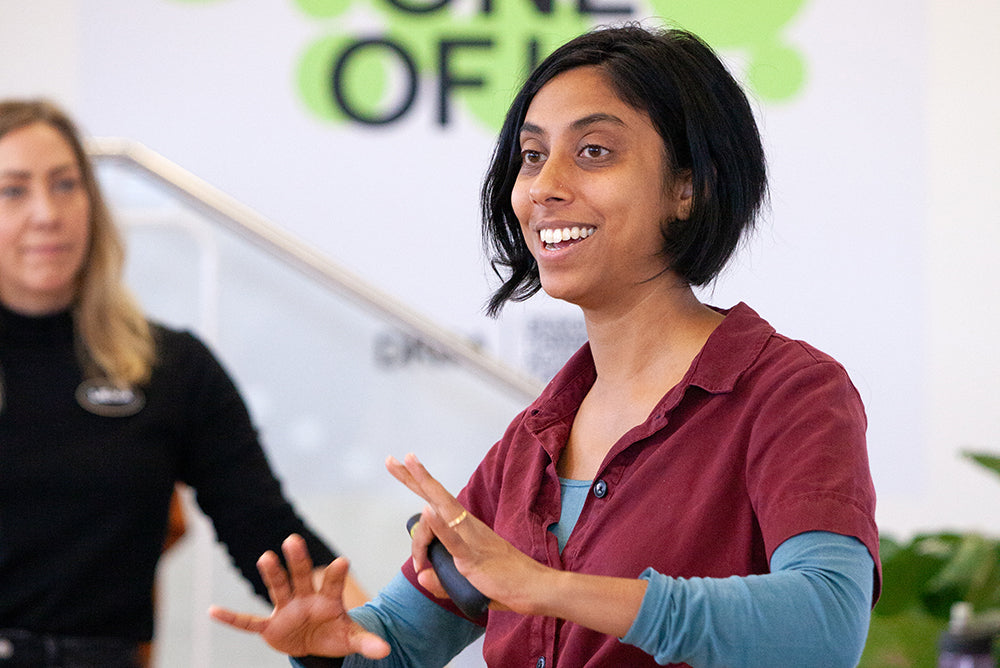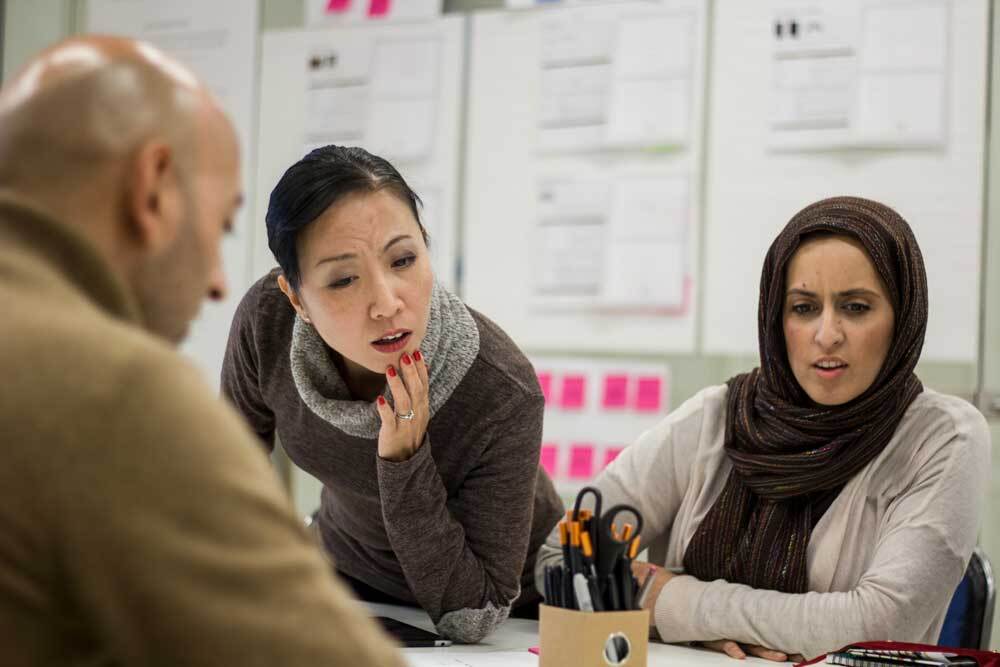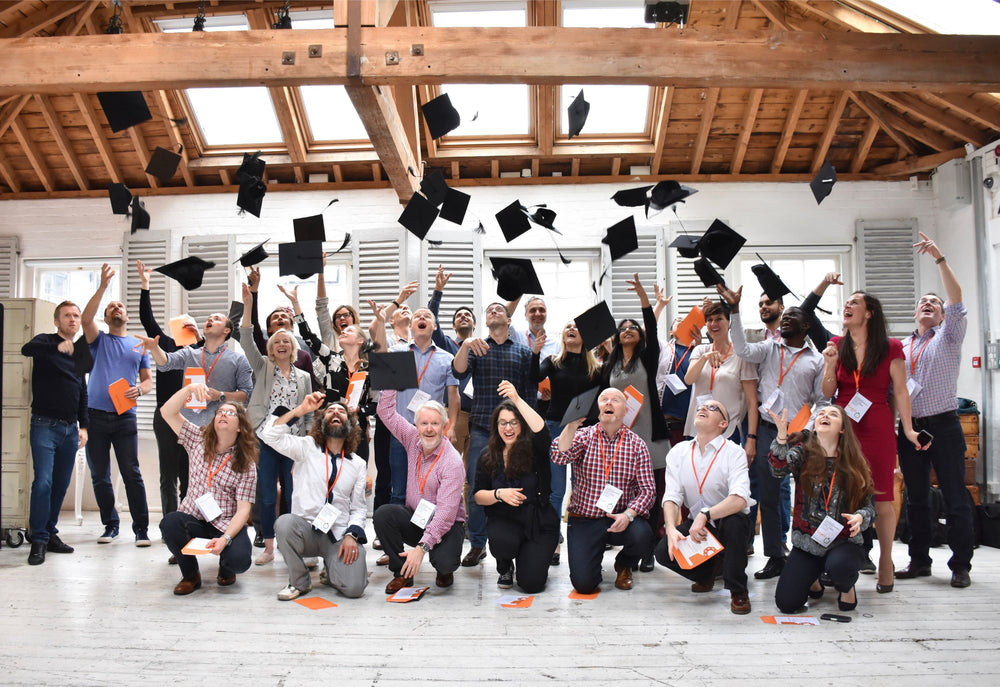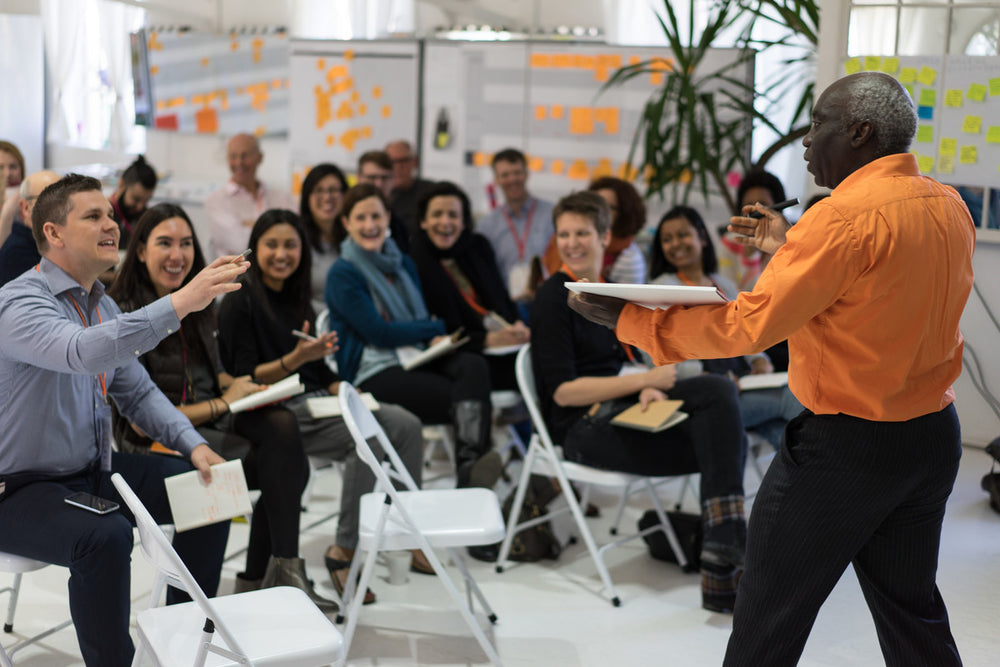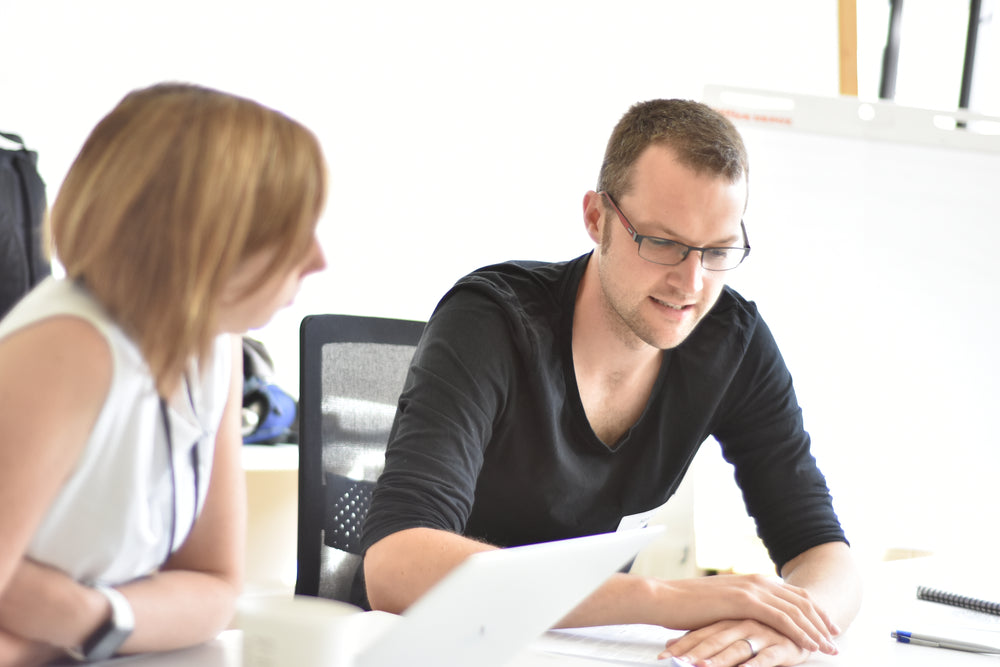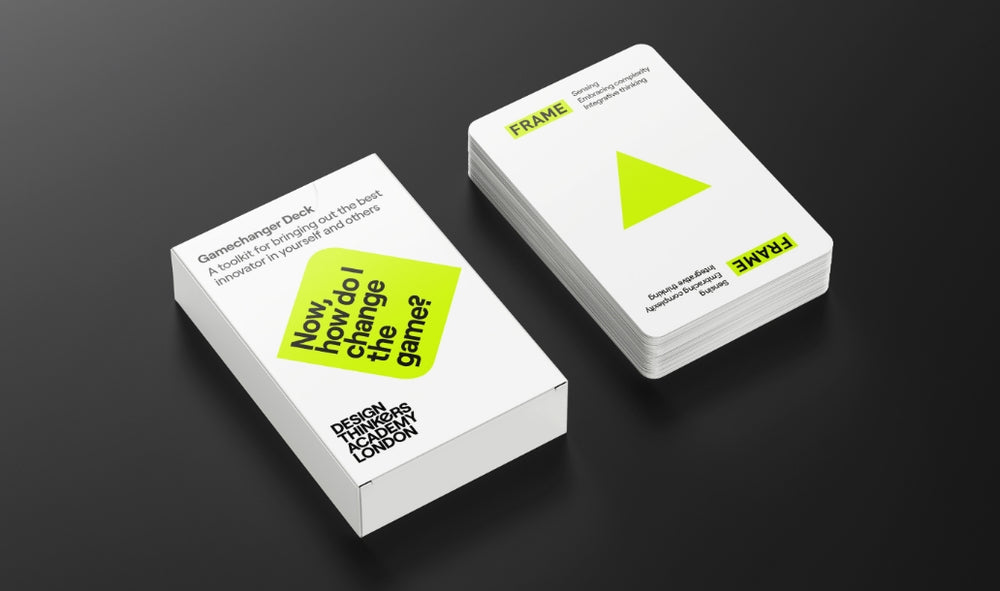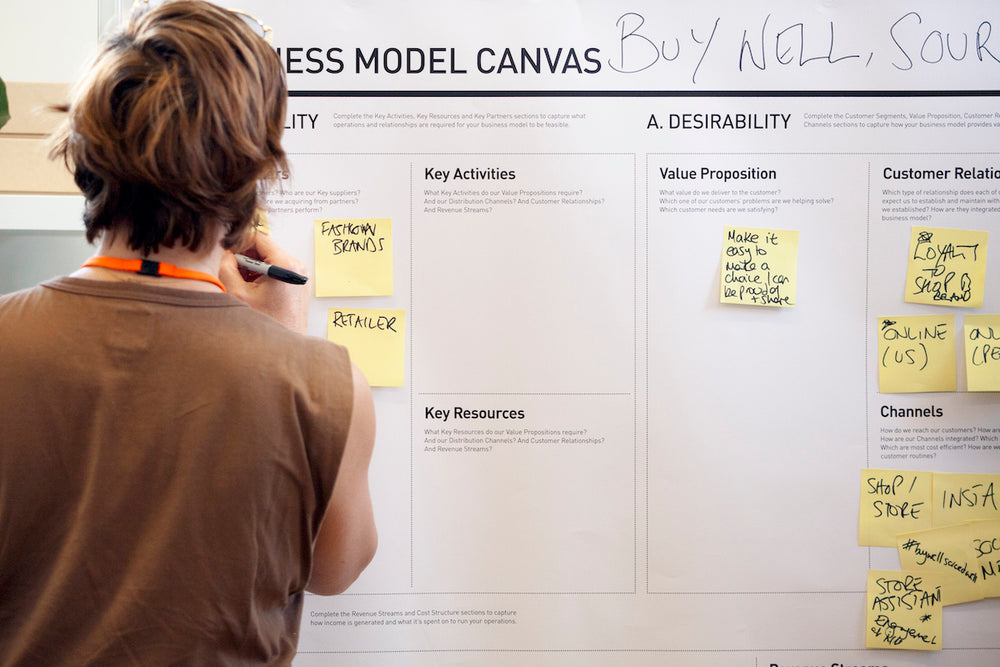How can design make the process of integration for a refugee faster? In this long read service designer Kartik Sharma argues that rather than looking at a problem and trying to define it, we should ignore it and ‘un-learn’ it first in order to look at all angles.
Jan 2016
“you know what”, I said “they should throw some designer types at the current refugee problem and see what solutions they can come up with”.
June 2016
If you’ve followed the news lately or over the last 18 months the horrendous situation in Syria has pushed a lot of it’s population out into Europe seeking asylum. It is hairy, and scary.
I was in Amsterdam recently for a week-long course on Service Design Thinking. This is run by the Design Thinkers Academy.
The design thinking course we knew would have begun with a hairy problem. We would not know what it was. We would have been expected to use the tools provided to ideate and create a solution. We would have no more than a week. Little did I know this would be a throwback to my remark in January AND I’ll get to design a solution.
The Design Council’s 'Double Diamond'
Design thinking follows a process of 4-step process of 'Discover, Define, Develop and Deliver'. Although there are more than one variant of the process I find the UK Design Council’s Double Diamond the easiest to understand and follow, a good structure and clarity — this is also what we used for this Bootcamp.
This organisation helps speed up the process for refugees to integrate in Dutch society. Himself a refugee from Syria, and arrived in The Netherlands just over a year ago, Jay is spearheading this organisation to help other Syrian refugees integrate and be part of productive society. Jay’s challenge for us was “Once given permission to work, can you help us design a solution that makes the process of integration for a new refugee faster?”
The solution needed to be designed in the week. We were divided into teams of 6–7 and asked to start. The first day of the week started with Jay’s introduction to the problem, as defined above. Followed by an introduction to Market Research by Els Dragt from MARE research.
Market research
Well, simply put you need to understand both Qual and Quant methodologies to really get a hold of the problem you’re facing. Marketers reading this are nodding everywhere. Yes, Quant provides the right numbers but Qual is more about whats not been said. It gives you a way to listen to the non-verbal signs. Els talked about how to look for body language and other signs while collecting information which will help build a complete picture of your persona. This starts with researching as many aspects of the challenge as you can but then quickly identifying the persona, problem, and the stakeholders.
Our client was The Refugee Company, and the challenge was to come up with a solution which enables Syrian refugees who await in one of the camps in Netherlands to be able to join Dutch society as productive individuals as soon as they get their permission to work. Networking, up-skilling, work experience without being legally able to work whether voluntarily or paid. Quite a task.
Each team was divided into 3 groups
- Interview recent refugees (potential persona — not sure?)
- Interview The Refugee Company (Client — maybe a persona?)
- Interview the Dutch public (key Stakeholder) Desktop research (Market Research)
As part of the first exercise I decided to join the group who would interview the refugees. With a little anxiousness, Estefania from my group and I went into The Refugee Company. Keeping in mind what Els taught us about surroundings — What I saw was a start-up who is using every single inch of space available to “do something” for the refugees. They were huddled in groups on a big table, about 8 of the employees, all volunteers. There was some merchandise for sale. And there was a working area with sewing machines donated to them on one side. Right at the back was the kitchen.
I interviewed Jay Asad, who spoke about the facility, the process and timelines associated with seeking asylum from Syria, his own journey. We also delved into the process of leaving Syria, I wanted to get as much information to be really able to put myself in the shoes of an asylum seeker, as much as one can without being one. Jay told me about methods to leave the country, the emotional journey and touch-points including authorities and people smugglers and dodgy boats. I used this interview to dig deeper into the emotion and reasons or motives behind the persona’s intent. Keeping in mind both verbal and non-verbal information.
My second interview was with Faras who spoke to us about his own journey as a refugee from Syria. This really painted the picture for me and helped us all understand about the various educational backgrounds, work experiences, age and demographics of his fellow refugees. All seeking a way out into normal life once again.
At the same time part of my team was out on the street collecting information from the Dutch public, asking them open-ended questions about the refugee situation. It was essential to gain how the public perceived this challenge. For the most part we got a very interesting mix of answers and used this information to build the stakeholder map we are dealing with.
"It is incredibly important to not guide your interviewees and dig a bit deeper into the real emotions and answers behind what you might get when you just first ask a question."

Some tips to ask better questions:
- 5 Whys? — each time you get an answer ask Why?— repeat 4 times. This forces the interviewee to dig deep and you can get some gold.
- Look for non-verbal cues — folded arms, emotional reactions and try and explore more where you see a reaction that can be explored more as you see fit.
- Take photos and make short videos where you can to remind you of the space you operated in. When you get 30 seconds, use your nose and smell the surroundings to really use all senses.
- Listen, or your tongue will make you deaf. Always best to have a partner taking notes when you ask the questions. If you cannot afford this, let the interviewee know you will be writing down in between so you can remember everything they tell you.
Re-framing
“What is the sum of 5 plus 5?”
“What two numbers add up to 10?”
Notice the difference in these two? The first question has only one correct answer. The second one has many answers.
As the week progressed we had David Kester (ex-Head UK Design Council) as our coach for the second day. David, a master at design thinking built on re-framing a problem so it captures the exact essence of the wicked problem we are solving. We all know we look at the world with our own set of lenses. We have been conditioned to do so. Education, experience, time (lack of) and a solution-driven culture all factors leading up to a mentality of rushing to defining a problem using the very set of traits we have accumulated over the years. This is not necessarily a bad thing, mostly. I’ve read before how jumping to a solution is a result of evolutionary traits. However, when looking to define a problem, we must ignore all this. Un-learn and look at all angles.
In my case this started with really going back to what Jay had said about the problem of speeding up the process for refugees. By now, we have collected a ton of information. We have photos, interview notes, official refugee policy information, more questions(!)

“But, wait.”
“We do not have any control over Immigration policies.”
“yes, and sometimes refugees are forced to change camps”
“How about the persona’s emotional journey”
“Wait, who is the persona?”
“What would it take to make the client’s company a success?”
“Also remember guys, COA (Dutch Immigration) is a stakeholder.”
“Ok, wow. Cool”
All this leads to a very confusing dump of information where my group is now struggling to make sense of it all. We had moments where everyone wanted to share something and the confusion would increase even more. I was chosen as the Chief Happiness Officer — someone who makes sure everyone gets a chance to speak and that everyone is participating in the process. My task was to foster collaboration and keep the conversation moving along. because time was limited and we had to move onto prototyping soon.
Penny drop 1 — Our client is the Refugee Company and not the actual refugee. We cannot influence an individual and need to design a solution using the client to support the refugee’s journey.
Penny drop 2 — The persona in this case, is the refugee, for whom the client wants to design a solution that fits with his emotional journey and enables to find him a space in Dutch society as soon as he is ready to start work.
What do we know:
- A complete breakdown of COA’s policy on asylum seekers and refugees
- The scale of the problem — refugees skill-sets and experiences. · Data on number of refugees, ethnographic information, costs of housing
- An understanding of timelines on visa processing
- A deeper understanding of the emotional as well as the actual physical journey of a refugee in The Netherlands — empathy towards the persona.
- Detailed information on the workings of camps — the facilities, restrictions, capabilities and resources available to new refugee.
Re-framing
Before I get into re-framing some important notes to remember that might be useful
- Grouping helps — when collecting data from research have information grouped under headings or themes.
- Create a stakeholder value network map — aligning each of the key stakeholder identified into specific values they seek out of your solution. This is great for knowing who can influence a solution as opposed to who just needs a solution.
- Define the persona’s personal map in terms of benefits from your solution. What internal v external factors are at play? What can be influenced?
- The Design Thinkers Bootcamp course provided us with tools to help us really crystallise these which in turn makes sense or at least starts to make some sense of the mess. As shown on the image below “you are here”

Team’s emotional journey check: At this stage the group is a lot less confused than the prior 2 days. It seems like we can see a light at the end of the tunnel and feel like there is coherence. Agreeing on the persona and the dropping of the penny on the client’s requirements definitely helped me in understanding the challenge more.
Re-framing a problem or a challenge comes with its own well, challenges. It’s easy to pick the solution you want to design. It is very human to do so. But you must resist the temptation because you are not yet ready to build a concept. A clear reframed problem is yet to be defined. However at the same time it’s OK to reach a conclusion, a hunch on what it is that might be going on here. A solution though is a bit premature at this stage.
Client — The Refugee Company
Persona — name : Hamouda. Male. IT professional. 28 year old Syrian refugee. Arrived in The Netherlands in the last week. Has travelled through 3–4 camps before reaching The Netherlands and is currently awaiting a decision on his working permit.
Timeline — We expect he will receive his work permit in the next 5–6 months.
Emotional journey — Lots of turmoil leading up to the time Hamouda has reached The Netherlands. He has lost his family, a bleak future in his country and exposure to war has made him flee, he has been given a lot of (mis)information on his trip so far and is feeling a bit jaded. Over the last week while in The Netherlands he has been moved twice internally. The mood in the camp is unstable. Exposure to people outside of his normal social circle, although his fellow countrymen has led him to a state of confusion. There is limited networking and not enough clear information on how he might integrate into the Dutch society — his new home.
He is very unsure and anxious about his future, although now that he is in The Netherlands, his final destination, he is also cautiously excited for his future.
Here’s our reframed challenge:
“Given that Hamouda has been accepted to stay in The Netherlands how can we connect him to the most useful resources within 4 weeks that enable him to work from day 1 of getting his work permit”
Key take outs:
- Keep an eye on your persona’s emotional journey throughout this part to stay as close as possible to him/her.
- It is essential you avoid jumping to solutions, conclusions however are ok.
- What is the context of the environment? What are your persona’s goals, needs, values and concerns?
- Who / What are the key stakeholders — which departments are actively involved?
- Think up a story of his journey, you have the facts and you know what the persona is trying to do, i.e. his job.
- Quotes are powerful and nothing works like a real quote that embodies the persona’s challenges and his barriers.
Concept
Day 3 began with an introduction to the Concept stage by Ralf Beuker (Dean, Münster School of Design). Ralf took us through some of his recent projects and his journey into Design and Design Thinking while explaining some key tools and principles of the Concept stage. Ralf spent time discussing some basics of the What, How and Why are we using design thinking? How to really answer these questions and how designers apply POST.
Ralf noted how broadening the scope of a product or service is paramount to designing something that is nailing the brief. There is a well-known example about what people want — Marketing Myopia by Theodore Levitt.
"People don‘t want to buy a quarter-inch drill, they want a quarter-inch hole" (Which immediately reminded me of “What People Really Want”)
In both these examples the product delivers an outcome but the product itself, is not what the customer is looking for, if that makes sense.
"Design is using as a set of transformation means that support strategies based on objectives all aiming at people"
The teams now started to open up the second diamond and diverge into ideation phase. One or two quick ideation exercises on “a stupid idea” were kicked off. Pitch something ridiculous, they said. I might have come up with the idea of employing location-sensitive, trained dogs from the pound who charge battery packs as they run around who can then be “hailed” by an app to come to you as a rescue when you’re out and your phone / laptop battery is running out. I thought it was great. So that task times x 30 ideas from everyone in the group meaning a lot of crazy ideas — really got the juices flowing. Although it sounds a bit like nothing this exercise really helps. In fact, I wonder if you applied this as a short kickoff before a brainstorm in your team — might work?
Anyway, this is the stage where the solution-driver in me wanted to now hear about solutions. All of us took turns explaining where we were in the journey and the understanding of the facts and potentially pitch new ideas for a solution to be prototyped.
It’s really important to let the group contribute. It’s important to let everyone speak — one at a time. Meanwhile each person takes notes listening the ideas of others. The process works really well and no idea gets missed. Then each person display his own ideas on the wall and everyone votes for their favourite bits. This is democratic, and at the same time a great way to open up to new ideas that can be generated by fusing one or more together.
Build on the shoulders of giants
I read somewhere the best creatives steal. Well, not quite but a good way is to always think of other industries and similar problems solved elsewhere and bring into the ideation. This really helps because you start off by building on something that exists and has a bit of a framework. It is also easy for your team to understand something that is based on a real product or service they have seen or know.
We quickly realised that one of the best things we could do for our persona, who is educated, newly arrived, young and motivated is to set him up with a match in his industry. I think I said “a Tinder style match making” one of us said something about “training programs” and another about “industry experts and TED Talks”. There was also a short discussion about renaming the client’s company because The Refugee Company didn’t generate a positive feeling and might be better to change the name(!). All ideas were thrown in the pot.
Our idea finally manifested itself as an in-house training department where new refugees like Hamouda, can come and get to talk to industry experts in their line of work. They will be matched using a system designed to pick the best match in skills (Hamouda) to the demand (hirers). Even though Hamouda couldn’t work we would have sped up the process of introducing and networking which was a key goal of Jay’s.
We included a section where there can be regular TedTalk style events hosted by the Refugee Company. We will invite the Red Cross to spread the message across camps and people would join in from camps everywhere. Industry experts will be invited using social media and volunteers. We will be able to connect 30–40 refugees at each event. We will also provide ongoing communication and support where needed using volunteers.
Here is what it looked like in Lego.

Prototypes
Before I go into Concept development, let’s explore Prototypes a bit more — What is a Prototype?
A prototype is something you can engage with. It is a tool to help you communicate and test ideas. It is refined through iterations as the value proposition is further understood. When a prototype is ready it’s easier to tell (and sell) the story. I couldn’t comment on what the overlap is with what product managers call Minimum Viable Product. But in my mind the prototype is just maybe a step before that. It is the prototype that will lead to the MVP. It’s something that can be built right away.
We used a methodology that helped us create a concept out of the idea. Using the following resource we created a concept out of the idea.
- Tagline
- Accepted consumer belief [ACB]
- Introduction of the solution/Benefit
- Reasons to believe
- Price/costs
Following on from sharing our prototype with the stakeholders and persona, including the client we decided to group the feedback and here’s what we learnt.
Feedback - persona
- Loved the concept as a great networking tool — tick
- Where will we host the workshops? — OK, think.
- All round happy with the concept but some confusion about the mechanics — not bad, but need to articulate better.
- I don’t know if this will help but is a good step — value perhaps not 100% clear. Might be a challenge.
Feedback - Stakeholder (the Dutch public)
- REALLY happy that someone is doing something to help the new arrivals — BIG tick
- “how can I help?” — OK this was one of the things we would need volunteers for and trainers to run so this is a positive. Take some details of anyone who wanted to actually help. We got a few people.
- “I can’t really donate my time or money, so please don’t ask me” — Fine. Didn’t ask you to. Sounds like the concept is coming across as unwieldy or maybe people are just ignoring us a donation seekers.
Feedback - Client (The Refugee Company)
- I like the idea, your lego brings it to life — GOOD
- It would be great to focus on the part that helps speed up the process, seems like you’re doing too many things. — Umm, we thought we were focusing on this. OK — take the feedback on board.
- How will you communicate this to the refugees? — Great question. Clearly we didn’t think about this much but we always knew it will be a challenge. Stakeholders like The Red Cross would be detrimental in helping us spread this message in camps. We need a plan.
- How are you going to get the refugees out to the workshop? We had some answers here. Old bikes scattered all over this country could be repurposed — maybe? Seriously though.. anyway.
Our coach on the fourth day was Arnoud Koning from Procter & Gamble. Arnoud focussed on helping collect feedback and used a bunch of tools to then create a concept ready for “sale”. Stakeholder Management was the flavour of the day.
ACAS — Feedback from peers
At this stage we were looking for feedback from the rest of the teams on our ideas and solution. A tool used at this stage was ACAS
Amplify, Combine, Avoid, Substitute
As a group you pitched the idea to all the other fellow groups on the Bootcamp. Once you were done the audience would give you feedback grouped under either Amplify, Combine, Avoid or Substitute. In doing so you got more feedback towards what some of the issues in your solution are that might need one of the above 4 points.
This helped in more than one way. You ended up getting a view from ‘the others’ solving the same challenge. And also heard some other ideas that you could apply to improve your own concept’s iteration.
Iteration
It became clear that the solution was too unwieldy for the persona to understand and the client to implement. As the change agent we were required to iterate and focus on the one thing that would make the client’s life easier yet provide immense relief to the situation our persona is in. Quickly.
Yes, there are important bits in the concept that we created that will overcome and provide a solution to this challenge. Yes, there is a big need for a solution. But if you looked at it realistically with the aim of prototyping and (if need be) failing fast (which mind you we got some great feedback about) the concept ended up being too broad and wide. We started removing things that did not immediately help with “making it easier” to the persona.
More jiggery-pokery
Looking back and grouping all our feedback we learned a few important things and areas where we went broader than the brief. It was necessary as part of the project but when providing the final solution after learning what we had — only the bits that immediately made impact were really necessary.
Our group quickly felt like we’ve taken on too much and now we have to remove bits we were all passionate about. It could become quite hard.
We started with paring down the co-working space (the Lego model) primarily because it had become too much to manage for our client. As much as the idea was novel it seemed quite hard to manage the whole thing in one go. Almost move the client towards this organically.
We learned it was going to be quite a challenge getting refugees to come out of the camps in regional Netherlands to a centre in Amsterdam. Travel money, mode of transport, safety issues.
Immediately losing impact of the project, so we removed all camps that didn’t fall within the Amsterdam catchment area. Our focus shifted to Amsterdam only.
It became clear by paying attention to the emotional journey of the persona (as plotted by our team) that at this particular point in time our persona is feeling a bit disillusioned by either the lack of reliable information and in some cases too much information on what to do next. This made us focus on one particular stage of the journey — right after the persona is accepted to stay in The Netherlands.
This helped direct all energy and focus on the most vulnerable moment, the point in the timeline where the client can really make a huge impact.
Success will breed further success — if we can prove the concept in one location we can prove success and the value added. This will potentially bring in funding and further change in the landscape. Allowing us to build on this concept further. Our client can then be equipped with a reliable, tested concept to replicate this solution in other places.
The organisation relied on volunteers who donated time and money; and some part-time paid staff to run the operation. They have existing relationships and workload to manage and adding more staff in a short amount of time would prove difficult. For an organisation running on the smell of an oily rag it’s crucial to deploy resources where most impact can be generated.
The concept thus created was one which satisfied the persona, was focused on a specific time in the journey where most impactful and enabled the client to execute tomorrow. There was nothing stopping them from implementing this and was a scalable model. Specific, impactful, generally awesome.
Final concept
We named our solution “&UConnect”
The Refugee Company will connect Dutch entrepreneurs and organisations who are able and willing to share their time. We will promote the connection and use their expertise guiding newly accepted & skilled Syrian refugees waiting for work permits, to further develop their skills in their respective fields. In return the entrepreneurs gain great talent to help build their business, can become part of a solution.
The concept hinged on leveraging current workflows that exist between the client and refugees in camps. Volunteers will promote a day at the Refugee Camp office where refugees in a certain skill-set (in our case Hamouda will be interested in attending Programming and IT) will be invited to enrol to register their skills with The Refugee Company.
At the same time The Refugee Company will use volunteers armed with information about a new program designed to help newly accepted & skilled refugees who are now looking to network and speed up their assimilation and integration into the society. They will use a combination of social media profiles and reach out to local businesses with this message.
Once we establish enough interest with 3–5 employers and 15–18 new refugees. We will put on a networking event where our personas, (Hamouda) can connect with these organisations. Once the contact is established volunteers will help identify skill gaps and with input from the businesses and local government-funded training programs these gaps will be filled.
In case there are no significant skill gaps, Hamouda can continue to explore and network with the entrepreneurs and businesses matched and interested to work with, until the work permit is issued (which is generally a maximum 6 months).
Dragon’s Den
Using the distilled concept the team now planned how to present the solution to the judges. We followed the principles of Sales101 and always keeping stakeholders in mind.
Focus on the situation — quickly crystallising and pointing out the stage in the journey of the persona. Bringing the reality of the struggle and the critical challenge to life.
State the idea and mechanism — matching Dutch employers with newly accepted and skilled refugees. The how.
Argue the key benefits of the solution and quickly move on to closing by demonstrating the easy next steps involved.
We decided to showcase this in a 3 minute skit. There might have been elements of interpretive dance — just kidding.
Hamouda, played by Lina Alzate. A newly accepted refugee who is a bit unsure and unable to find the best way to start networking to utilise his skills and get back to normal living.
I played a local Dutch employer, struggling to find good coders for my start-up in Netherlands. There is a lot of demand but very limited supply which in turn impacts my production schedules and sprints.
Estefania Farah played the service “&U Connect” and brought us together.
Pamela Caillens tied up the concept with an introduction to the what and the how. With supporting roles played by Robin Souter, Andrey Ivanov and Charlotte Schmidt.
Overall a smash hit. We fielded questions from the judges and explained the simple concept easily. At the end it turned out to be quite an easy job since we had put so much time into thinking of any possible questions that may arise. A key focus on the specific point in the timeline and an always-on mode for “how does this help our persona” followed by “does this answer the client brief” ensured we stayed on track. The detailed journey we planned earlier helped us a lot. There were no new technologies needed, could be started tomorrow with limited (existing) resources and most importantly with a lot of scope to scale.
Final day
The final day of the workshop encourages you to now think of how you are going to apply what you’ve learned. By using a set of tools to help you formulate and distill the learning experience towards a plan for yourself.
Overall it was a great experience. Run by a very switched-on facilitating team – Arne van Oosterom, Jeroen Weide and Tim Schuurman.
Plus great coaches, Els Dragt, David Kester, Ralf Beuker and Arnoud Koning as mentioned in my posts. The highlight for me was the networking and the opportunity to work with some really smart and amazing people from all over the world as part of the bootcamp, all trying to apply design thinking into their profession.
